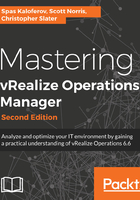
Do I need remote collectors and collector groups?
As we mentioned in the previous chapter, a vRealize Operations remote collector node is an additional cluster node that enables vRealize Operations to increase the number of objects that it can store into its inventory for monitoring. Unlike all other nodes, remote collector nodes only include the collector role of vRealize Operations. Collector nodes are not responsible for processing any analytics functions or storing any data.
Formatting of data is handled by the adapter on the Collector. Remote collector nodes always start communication with the vRealize Operations cluster. The cluster does not poll the remote collector for data.
Tactically, you deploy a remote collector node for any of the following reasons:
- So that you can navigate between firewall-protected networks
- Reduce network-related bandwidth between data centers or geographical locations where vRealize Operations components are being deployed
- To connect over wide area networks (WANs) to remote data sources
- Reduce the operational load on the vRealize Operations analytics cluster
What about collector groups?
If your environment has remote collectors, you can create a collector group, and add remote collectors to the group.
Use collector groups to achieve the following benefits:
- Adapter resiliency: If a collector in a collector group becomes unavailable, the total workload is redistributed within the collector group
- Load balancing: Automatically instantiates adapter instances based on the collector load of all adapter instances running in the remote collector group